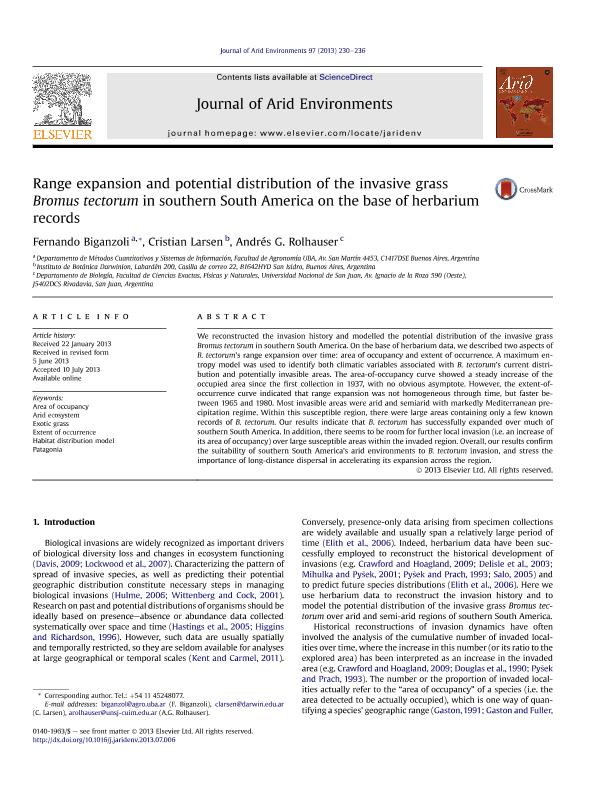Mostrar el registro sencillo del ítem
dc.contributor.author
Biganzoli, Fernando

dc.contributor.author
Larsen, Cristian

dc.contributor.author
Rolhauser, Andrés Guillermo

dc.date.available
2017-09-28T19:08:31Z
dc.date.issued
2013-08
dc.identifier.citation
Biganzoli, Fernando; Larsen, Cristian; Rolhauser, Andrés Guillermo; Range expansion and potential distribution of the invasive grass Bromus tectorum in southern South America on the base of herbarium records; Elsevier; Journal of Arid Environments; 97; 8-2013; 230-236
dc.identifier.issn
0140-1963
dc.identifier.uri
http://hdl.handle.net/11336/25336
dc.description.abstract
We reconstructed the invasion history and modelled the potential distribution of the invasive grass Bromus tectorum in southern South America. On the base of herbarium data, we described two aspects of B. tectorum's range expansion over time: area of occupancy and extent of occurrence. A maximum entropy model was used to identify both climatic variables associated with B. tectorum's current distribution and potentially invasible areas. The area-of-occupancy curve showed a steady increase of the occupied area since the first collection in 1937, with no obvious asymptote. However, the extent-ofoccurrence curve indicated that range expansion was not homogeneous through time, but faster between 1965 and 1980. Most invasible areas were arid and semiarid with markedly Mediterranean precipitation regime. Within this susceptible region, there were large areas containing only a few known records of B. tectorum. Our results indicate that B. tectorum has successfully expanded over much of southern South America. In addition, there seems to be room for further local invasion (i.e. an increase of its area of occupancy) over large susceptible areas within the invaded region. Overall, our results confirm the suitability of southern South America's arid environments to B. tectorum invasion, and stress the importance of long-distance dispersal in accelerating its expansion across the region.
dc.format
application/pdf
dc.language.iso
eng
dc.publisher
Elsevier

dc.rights
info:eu-repo/semantics/openAccess
dc.rights.uri
https://creativecommons.org/licenses/by-nc-sa/2.5/ar/
dc.subject
Patagonia
dc.subject
Habitat Distribution Model
dc.subject
Arid Ecosystem
dc.subject
Exotic Grass
dc.subject
Area of Occupancy
dc.subject
Extent of Occurrence
dc.subject.classification
Bioquímica y Biología Molecular

dc.subject.classification
Ciencias Biológicas

dc.subject.classification
CIENCIAS NATURALES Y EXACTAS

dc.title
Range expansion and potential distribution of the invasive grass Bromus tectorum in southern South America on the base of herbarium records
dc.type
info:eu-repo/semantics/article
dc.type
info:ar-repo/semantics/artículo
dc.type
info:eu-repo/semantics/publishedVersion
dc.date.updated
2017-09-28T18:15:34Z
dc.journal.volume
97
dc.journal.pagination
230-236
dc.journal.pais
Países Bajos

dc.journal.ciudad
Ámsterdam
dc.description.fil
Fil: Biganzoli, Fernando. Universidad de Buenos Aires. Facultad de Agronomía. Departamento de Métodos Cuantitativos y Sistemas de Información; Argentina. Consejo Nacional de Investigaciones Científicas y Técnicas; Argentina
dc.description.fil
Fil: Larsen, Cristian. Consejo Nacional de Investigaciones Científicas y Técnicas. Instituto de Botánica Darwinion. Academia Nacional de Ciencias Exactas, Físicas y Naturales. Instituto de Botánica Darwinion; Argentina
dc.description.fil
Fil: Rolhauser, Andrés Guillermo. Universidad Nacional de San Juan. Facultad de Ciencias Exactas Físicas y Naturales. Departamento de Biología; Argentina. Consejo Nacional de Investigaciones Científicas y Técnicas; Argentina
dc.journal.title
Journal of Arid Environments

dc.relation.alternativeid
info:eu-repo/semantics/altIdentifier/url/http://www.sciencedirect.com/science/article/pii/S0140196313001262
dc.relation.alternativeid
info:eu-repo/semantics/altIdentifier/doi/http://dx.doi.org/10.1016/j.jaridenv.2013.07.006
Archivos asociados
